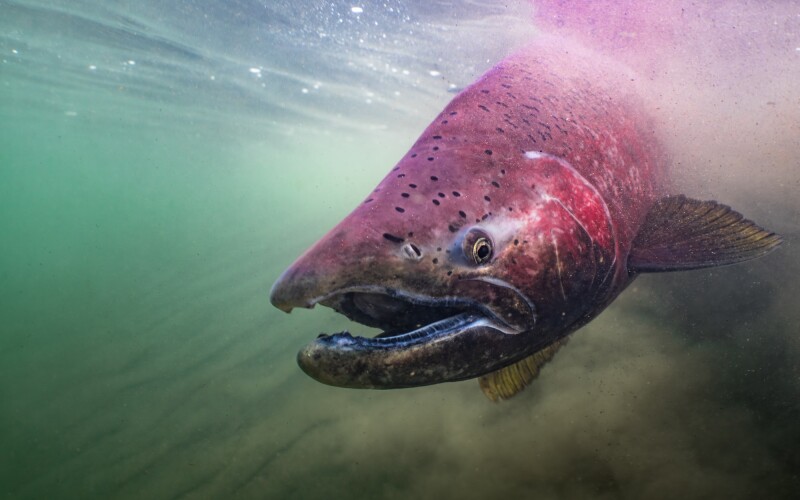The Washington State-based Wild Fish Conservancy filed a 68-page petition to list Gulf of Alaska chinook salmon under the Endangered Species Act Jan. 10. The action comes as the latest round in the organization’s quest to shut down Alaska trollers who focus on chinooks as part of their allocation under the Pacific Salmon Treaty.
The petition to list chinooks under the ESA is an aside to a battle that has been brewing in the courts for several years. The premise of the court filings had been to protect the Gulf of Alaska chinooks as forage fish for a pod of 74 endangered killer whales in Puget Sound.
“They’re actually taking it to the next level,” says Tim Bristol, executive director of SalmonState, in Juneau. “They were focused on the orca before, but this time they’re coming from a different angle. The ESA is blunt tool.”
“For decades, scientists have been sounding the alarm that Alaska’s Chinook are in dire trouble,” said Emma Helverson, executive director of the Wild Fish Conservancy, in the group’s statement on the petition filing.
“Despite existing management plans and years of efforts by the state of Alaska, chinook salmon continue to decline in abundance, size, diversity, and spatial structure throughout the state,” said Helverson. “Through this action, we are asking the federal government to undertake a formal status review and implement protections warranted under the Endangered Species Act, including designating critical habitat protections, to ensure the survival of these iconic fish.”
“Most people are unaware that there are chinook populations in Alaska in far worse condition than chinook in other parts of the Pacific Northwest that already receive protection under the Endangered Species Act due to their severe condition,” said Conrad Gowell, a biologist with Wild Fish Conservancy and co-author of the petition. “Ironically, certifiers and the seafood industry are leading concerned consumers to believe Chinook from Alaska are sustainable, when in fact they are disappearing before our very eyes.”
The main argument in the court cases was that NMFS in its biological opinion as part of the treaty allocation did not consider a portion of the commingling stocks as forage fish for the whales, which puts the agency out of compliance with the Endangered Species Act. Wild Fish Conservancy analyses provided to the lower court alleged that trollers foregoing their seasons would provide enough surplus chinooks to thwart the declining population of killer whales.
WCF claims that 97 percent of the troll-caught chinooks originate in drainages outside of Alaska. The Alaska Department of Fish and Game, meanwhile, estimates that between 30 percent and 80 percent of the fish in the harvest come from drainages outside of Alaska, and that the percentages vary each year. Additional information gleaned from in-fishery sampling of the troll fishery estimates that the Alaska fleet caught a total of 917 ESA fish of
Just days before the traditional chinook opening date of July 1 last year, however, judges in the federal Ninth Circuit Court of Appeals overrode the decision in the lower courts and granted trollers a stay that allowed them to fish. That ruling was the second time a higher court ruled in favor of fishermen in a suit brought by the WFC challenging the biological rationale in setting allocations of Pacific Salmon Treaty chinooks.
In the meantime, NMFS has been working on an analysis that the industry believes will vindicate the trollers of legal challenges and prove that they cause minimal impact on commingling chinook stocks.
“They’re just playing hardball,” says Bristol of the petition to list the salmon as endangered. “They wanted an injunction against the fishery in the courts and they didn’t get that.” Bristol adds that catastrophic returns of chinooks in the Bering Sea and the Kuskokwim and Yukon Rivers would seem to warrant more attention than the healthy stocks of the Gulf of Alaska.
“They just ignored that,” he says of the petition, which is specific to the Gulf. "There are a whole lot of problems with salmon elsewhere, and all those ESA filings to protect salmon down in the Pacific Northwest haven't been very effective."
The 2023 allocation for summer troll chinooks had been set at 149,100. During last year’s season, the fleet harvested 95,947 chinooks at an average ex-vessel price of $5.93 per pound. With a quota of 45,000 non-hatchery produced chinooks, the winter troll the Southeast winter troll fishery opened on Oct. 11, 2023 and will continue through March 15. As of Jan. 7 the fleet of about 50 boats had landed 17,298 chinooks.







